Discover the six trends that will drive advertising and marketing in 2026 – from multi-layered campaigns to emotioneered moments – and the strategies to build engagement and conversion
Cassandra Napoli, Elizabeth Tan, Raeesa Brey & Isabella Ventura
01.23.25 – 37 minutes
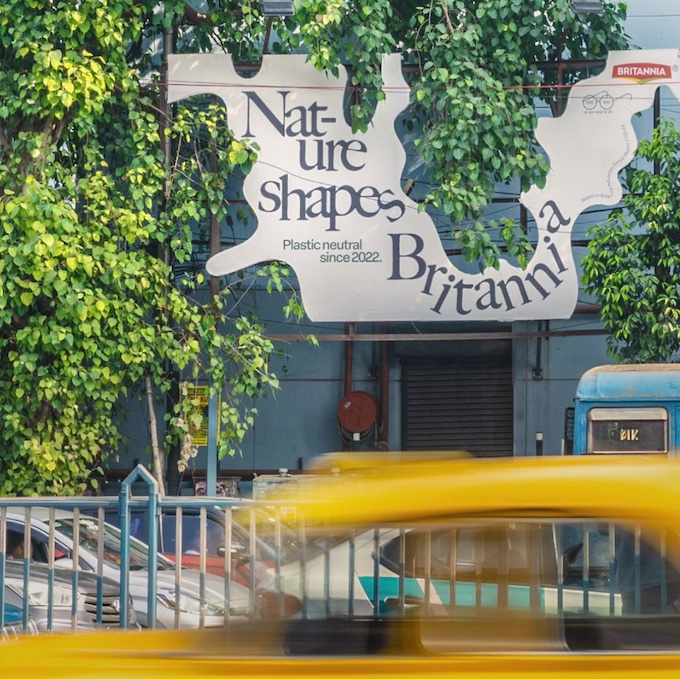
Need to know
2026 will be the year of redirection, when people and organisations channel their efforts to find collective and novel solutions to global challenges. Marketers will need to rethink strategies, use new tools and tactics, apply intentionality and double down on the power of emotions to achieve conversion.
Opportunity
The marketing sector will reach an inflexion point in 2026 as a result of shifting values, rapid tech-celeration and growing global tensions. While polarisations will grow deeper, giving rise to new challenges and uncertainties, there will also be new opportunities, with the acceleration of AI and the growing culture of convergence (the intersection of consumers’ multi-pronged interests) requiring multi-layered marketing strategies.
The coming years will be defined by trend tensions and an intergenerational consumer culture. Established brands will need to carefully toe the line between honouring their heritage and legacy to win over existing customers and learning new languages to win over both Gen Z and Gen Alpha, the latter of which will reach their teenage years by 2026.
Strategies
- Leverage multi-layered marketing: seamlessly integrate products, values and messaging across diverse channels to create lasting consumer connections
- Apply intersectional targeting: use this marketing framework to identify the psychological and social factors that affect consumers’ purchasing decisions
- Explore storytelling on the soft/chaos scale: use a two-pronged approach to storytelling, balancing softer narratives with chaotic, snackable stories
- Apply the rules for the new value system: embrace a fresh value system centred on empathy to resonate with an audience more aware of class dynamics and social equity
- Develop emotioneered moments: harness the power of emotions to connect with consumers seeking positivity amid societal challenges
- Apply intention to creativity: dream up more meaningful ideas, prioritising quality over quantity as intentionality becomes critical in 2026
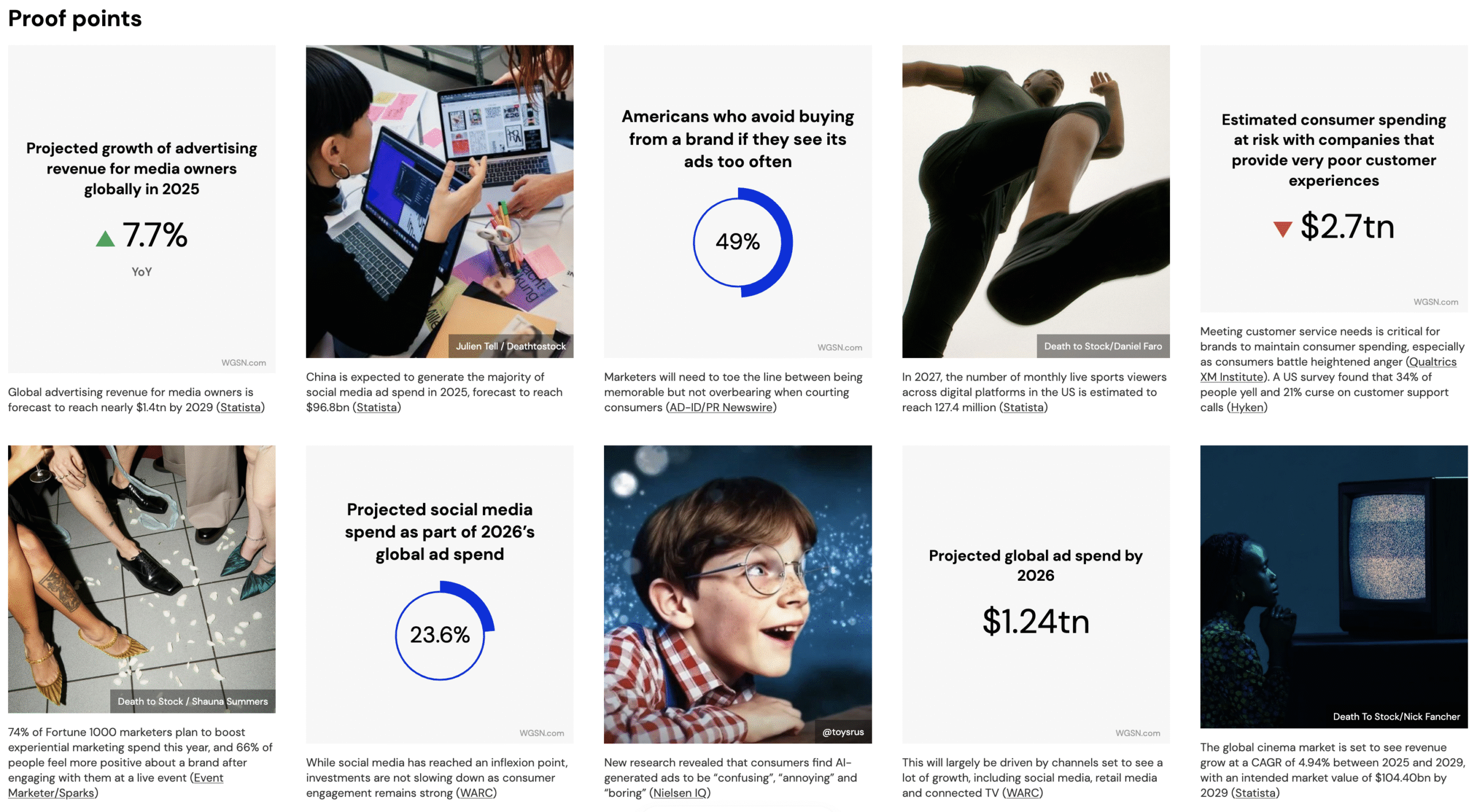
Leverage multi-layered marketing
Multi-layered marketing will empower brands to seamlessly integrate their products, values and messaging across diverse channels, creating lasting connections with consumers.
Strategy 1 – Win with sports marketing
Strategy:
- Align with athletes to amplify messages and engage communities. The future of sports marketing isn’t just about sponsorship, it’s about embedding the brand into athletes’ and fans’ lives.
- In 2026, the FIFA World Cup in North America and the Winter Olympics in Milan will amplify sports’ global influence, providing brands unparalleled opportunities to integrate into sporting journeys, from preparation and performance to recovery and lifestyle.
- Capitalise on sport’s momentum by engaging fans of teams and individual athletes across industry sectors. Athletes will continue to take centre stage as cultural icons with impressive personal followings and cross-industry interests. No longer just competitors, they will become curators of cool and culture, connecting fans with new products, ideas and experiences. Look to embrace female fandom in particular, as nearly 75% of women now identify as avid sports fans, up 10% in the last three years, presenting lots of cross-industry collaborations, especially in fashion (The Collective). Considering 64% of Millennial and Gen Z women enjoy the NFL, new partnerships with female-founded brand Betches Media aim to capitalise on the momentum (Morning Consult).
- Athletes’ lifestyles, training routines and philosophies will captivate Gen Z in particular, who will root for individuals over teams, and Gen Alpha – 60% of whom have already watched a pro sports event on TV and 47% have watched college sports (Morning Consult). College sports could be ripe for investment with NIL (name, image, likeness) deals set to exceed $2.5bn between 2025 and 2026 (Reach Capital).
- As niche will be the new norm by 2026, consider embracing emerging niche sports categories, especially in APAC. China’s sports market is expected to generate $2.42bn in revenue in 2025 (Statista), and Indonesia launched a new visa to facilitate travel for athletes and tourists attending sports events.

The NFL appointed Kyle Smith as its first Fashion editor, creating new opportunities for men’s fashion in the sports sector. This is part of the NFL’s broader strategy to modernise its brand and connect with younger audiences by tapping into the power of fashion. The move aims to support athletes in building their brands via strategic partnerships
In action
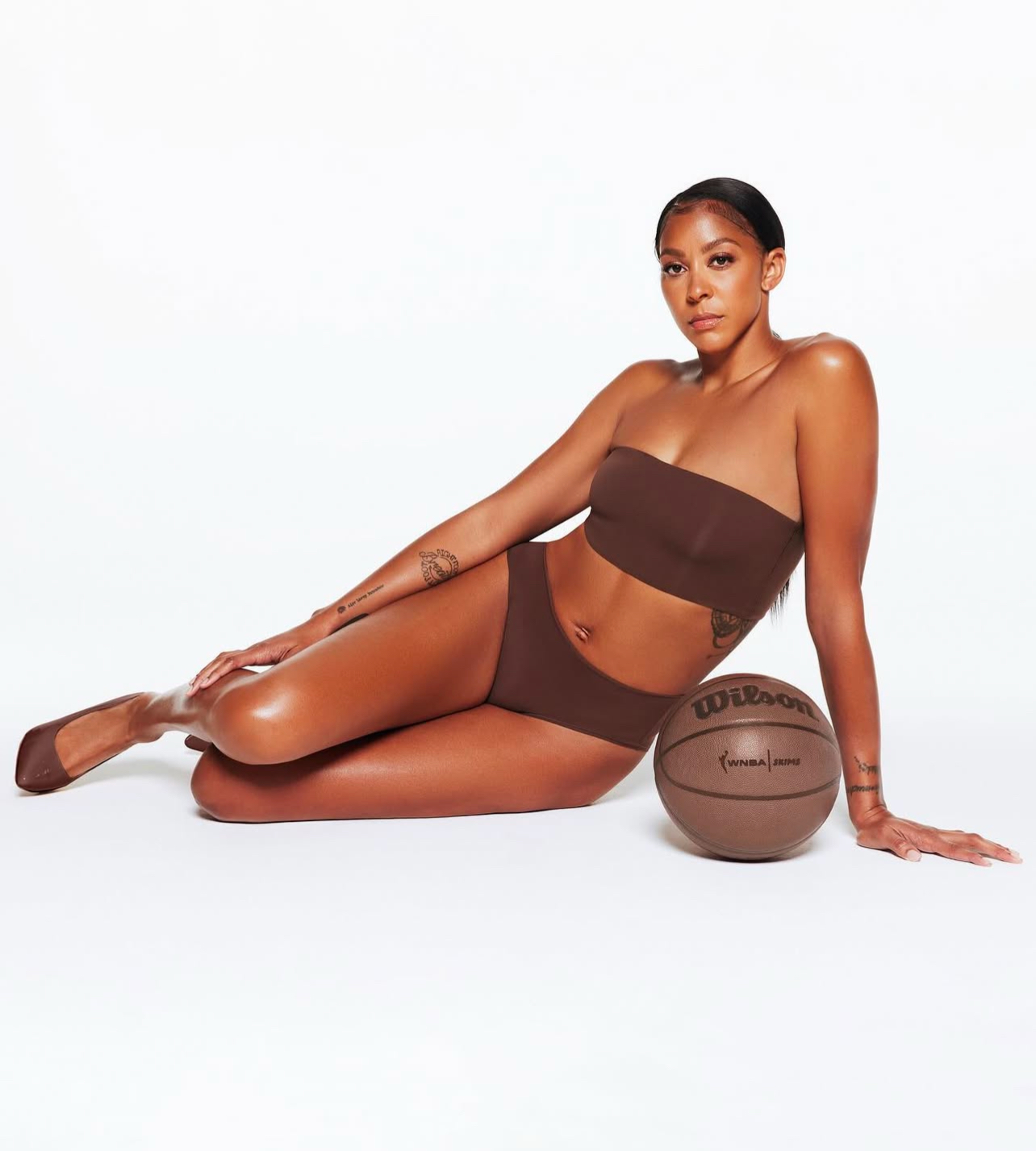
SKIMS partnered with the WNBA and spotlighted Cameron Brink, Candace Parker, Kelsey Plum and Skylar Diggins-Smith. This follows the 2024 WNBA Draft, which was the most viewed ever, with 2.45 million viewers (ESPN)
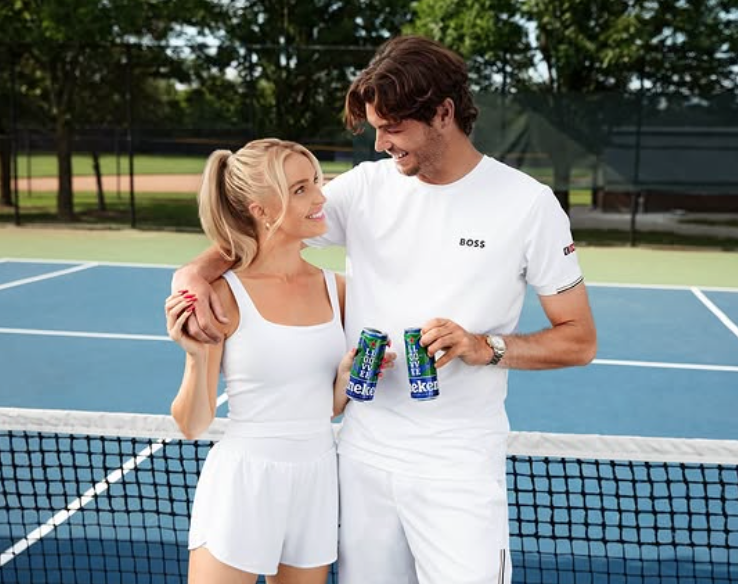
Y2K continues to influence the marketing landscape, with young audiences driving renewed interest in partners of athletes. Taylor Swift sparked a surge in Chiefs jersey sales, for instance, and Heineken featured Morgan Riddle, tennis star Taylor Fritz’s girlfriend, in its zero-proof beer campaign. WAGs have emerged as impactful channels for engaging audiences and amplifying brand reach
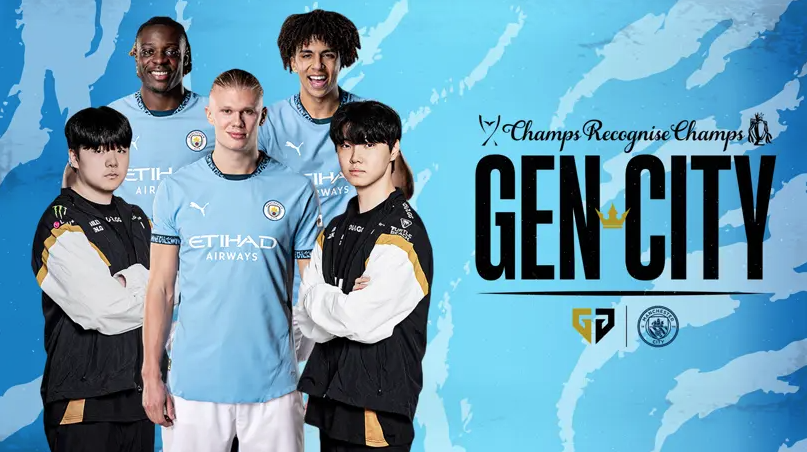
The global esports market is growing, with revenue projected to hit $4.8bn by 2025, with a CAGR of 5.54% (2025 – 2029) driving the market to $5.9bn by 2029 (Statista). Recognising this, English football club Manchester City’s esports division teamed with esports powerhouse Gen.G ahead of the League of Legends Worlds tournament, which is played across Berlin, Paris and London. Cross-event collaborations in the sporting space can unlock new audiences and drive engagement, with lots of room for brand integrations
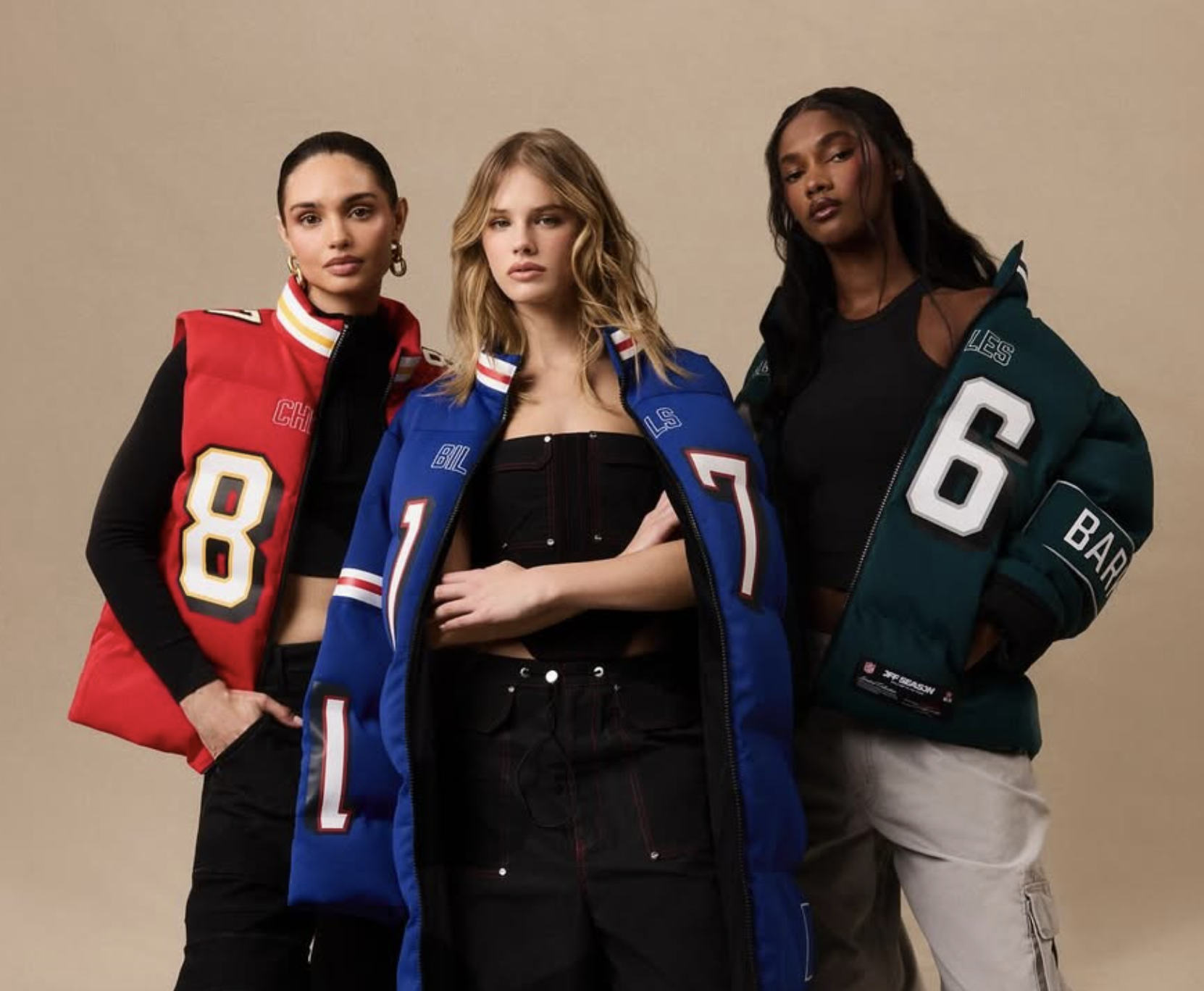
NFL WAG Kristin Juczcyk teamed up with fashion executive Emma Grede to launch apparel brand Off Season in partnership with the NFL and Fanatics, operating at the intersection of fashion and fandom

Strategy 2 – Build play worlds
- Extending the 2025 concept of world-building, marketers will opt to build their own universes that serve as extensions of their identity and will evolve into entertainment entities in their own right. Integrating the power of play into strategies will be essential to capture lasting engagement.
- With the number of video game users worldwide expected to reach 3.02 billion by 2029, gaming has entered the mainstream, serving as a social space where players and brands spend time establishing emotional connections (Statista). 43% of players value the interactive and social aspects more than the gameplay itself (ZBD). Create branded gaming universes that connect creators and communities, delivering glimmers and fostering inclusion to resonate with users who are balancing feelings of stress and boredom.
- Play will become a critical tool to create change and foster joy and inclusion amid uncertainty. Whether lighthearted games or more meaningful challenges, play will bring people together and connect generations and communities. Help consumers cope with the polycrisis by creating physical and digital playscapes that demonstrate a commitment to fun and silliness while boosting overall wellbeing.
- Restaurant chain Chick-fil-A (US) launched its app, Chick-fil-A Play, with original content programmes and games for kids and their parents
- To promote season two of Squid Game, Netflix launched the Squid Game Experience in New York’s Koreatown, where audiences could play a (less deadly) version of the game and enjoy Korean cocktails and snacks
- Chewing gum brand 5 Gum and musician Zedd launched a social media scavenger hunt requiring audiences to locate clues to decipher the hints on their social accounts and unlock the location of a secret rave party
During San Diego Comic-Con, mobile game company Supercell promoted its Clash of Clans game with a mock bathroom installation where fans could play the game while sitting on mock toilets – a playful nod to the fact that 50% of gamers admit to playing while on the toilet (Ad Age)
In action
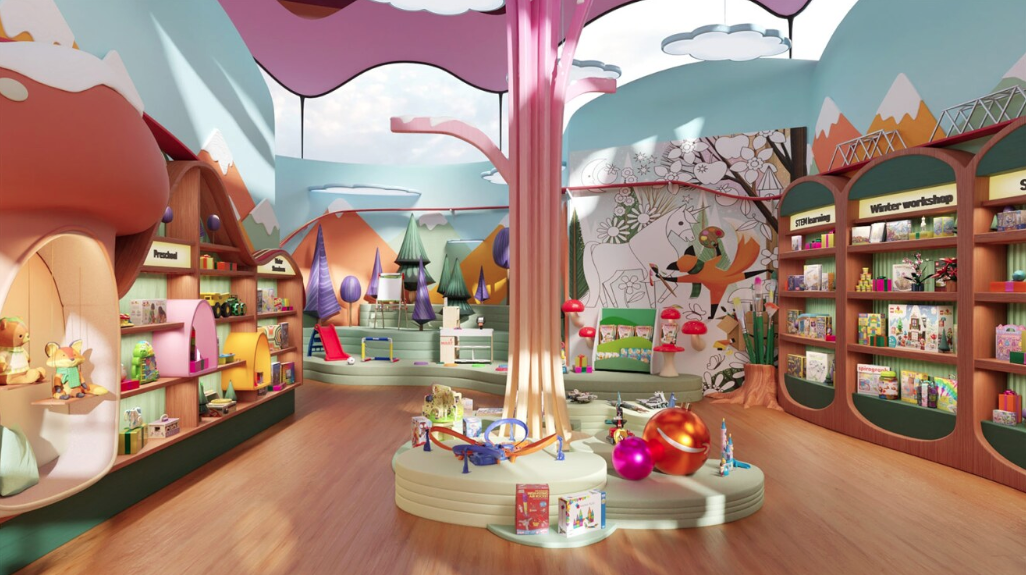
For the 2024 end-of-year Holidays, Amazon unveiled a 3D Virtual Holiday Shop with showrooms that let customers explore and purchase items by interacting with their digital counterparts. Adding a layer of gamification, the shop featured hidden portals that led to Disney and Harry Potter-themed stores, creating an engaging and exploratory shopping journey

Fortnite, Twitch and Amazon Ads joined forces to create The Glitch, a network of custom-branded worlds designed to reflect each sponsor’s unique identity. Domino’s launched a fully modelled virtual pizzeria, where players could host parties that enhanced the gameplay and restored their character’s health, seamlessly blending entertainment with brand interaction
Powered by Walmart, e.l.f. Cosmetics created a virtual beauty kiosk in Roblox, where gamers could purchase a limited-edition e.l.f. Up! Pets Hoodie – an exclusive item celebrating the brand’s commitment to be cruelty-free. The activation extended into the physical realm, where certain products had digital twins that could be used on the platform
Strategy 3 – Facilitate brand cross-pollination
- Build cultural relevance (a new KPI) with seamless and strategic brand integrations. Create interconnected experiences that align with audience tastes to deepen connections and drive long-term loyalty. While 99% of marketers say that fandoms are important, only 62% say they target or engage with them in their strategies (Tumblr/Archrival). This gap offers an opportunity to connect and build loyalty with these dedicated communities.
In action
- JW Anderson seamlessly blends fashion and film by collaborating with director Luca Guadagnino on the films Challengers and Queer. Anderson designed costumes and extended the partnership by featuring the actors in LOEWE campaigns with creative direction by Guadagnino, creating a cohesive synergy that bridges fashion and entertainment
- Netflix collaborated with Mastercard and MGM Hotels to launch Netflix Bites, an exclusive culinary residency in Las Vegas that brings its most popular shows to life. The event features a Stranger Things ‘screen-to-table’ dining experience, offering fans and food enthusiasts dishes inspired by the iconic series and other hit titles
- DJ Peggy Gou partnered with Netflix to host a Squid Game-themed rave at London’s Drumsheds to celebrate the second season of the hit series. This activation merged music and entertainment in a unique convergence, highlighting the shared South Korean roots of both the series and the DJ
- Fanta’s Halloween campaign in Brazil brought the Beetlejuice Beetlejuice movie experience to life for Alexa users. To activate the game, users simply said “Wanta Fanta” three times via the Alexa app, mirroring the iconic repetition from the film. Once initiated, the experience entertained users with soundbites and offered them a chance to win exclusive prizes
Apply intersectional targeting
Intersectional targeting is a framework that helps identify the psychological and social factors that affect purchasing decisions. This approach recognises diverse needs and experiences which will enable brands to futureproof in a time of rising tensions and polarised habits.

Framework – Intersectional targeting
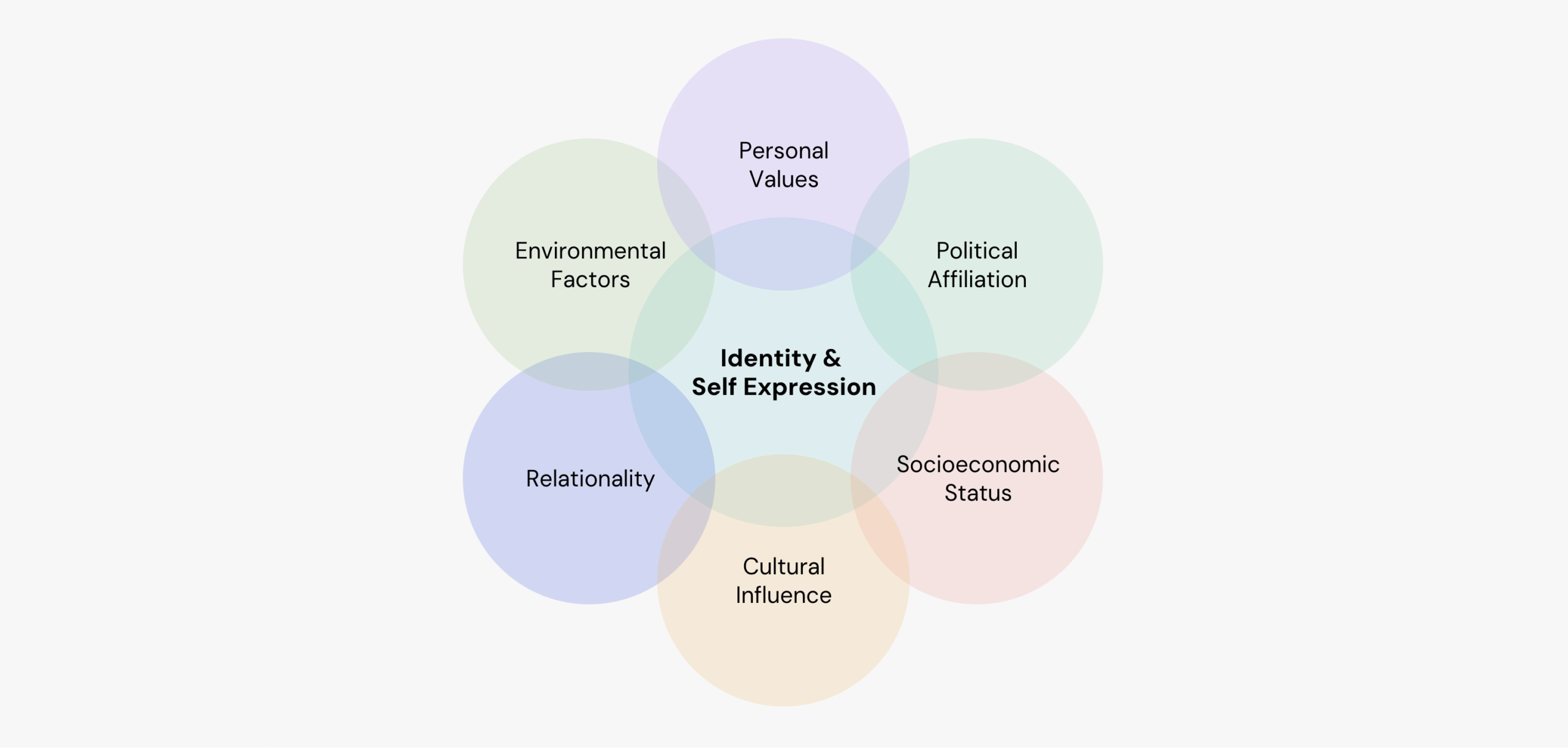
Strategy 1 – Prioritise ethics over aesthetics
- Swiss sportswear brand On partnered with Projeto Click na Favela in Brazil to launch a running club for the project’s students. It provided participants from Paraisópolis, one of Brazil’s largest favelas, with free shoes and encouraged healthy lifestyles
- Burger King partnered with São Paulo agency DAVID on a campaign that encouraged Brazilians to vote and educated them about the social impact of voting during the 2024 elections. Those who voted could bring their stubs to a Burger King to claim a free portion of fries or onion rings
- Heinz rolled out Reviews For Naturalisation, which helps refugees from countries such as Venezuela, Afghanistan and Ukraine who live in Brazil with the naturalisation process. Through the initiative, Heinz transformed positive customer reviews about immigrant employees at restaurants into formal recommendation letters that could be used as part of their naturalisation application process
- Olive oil brand Graza donated $10k to the World Central Kitchen to feed locals affected by the LA fires. It offered a supply of olive oil for cooking to restaurants and organisations providing food to first responders
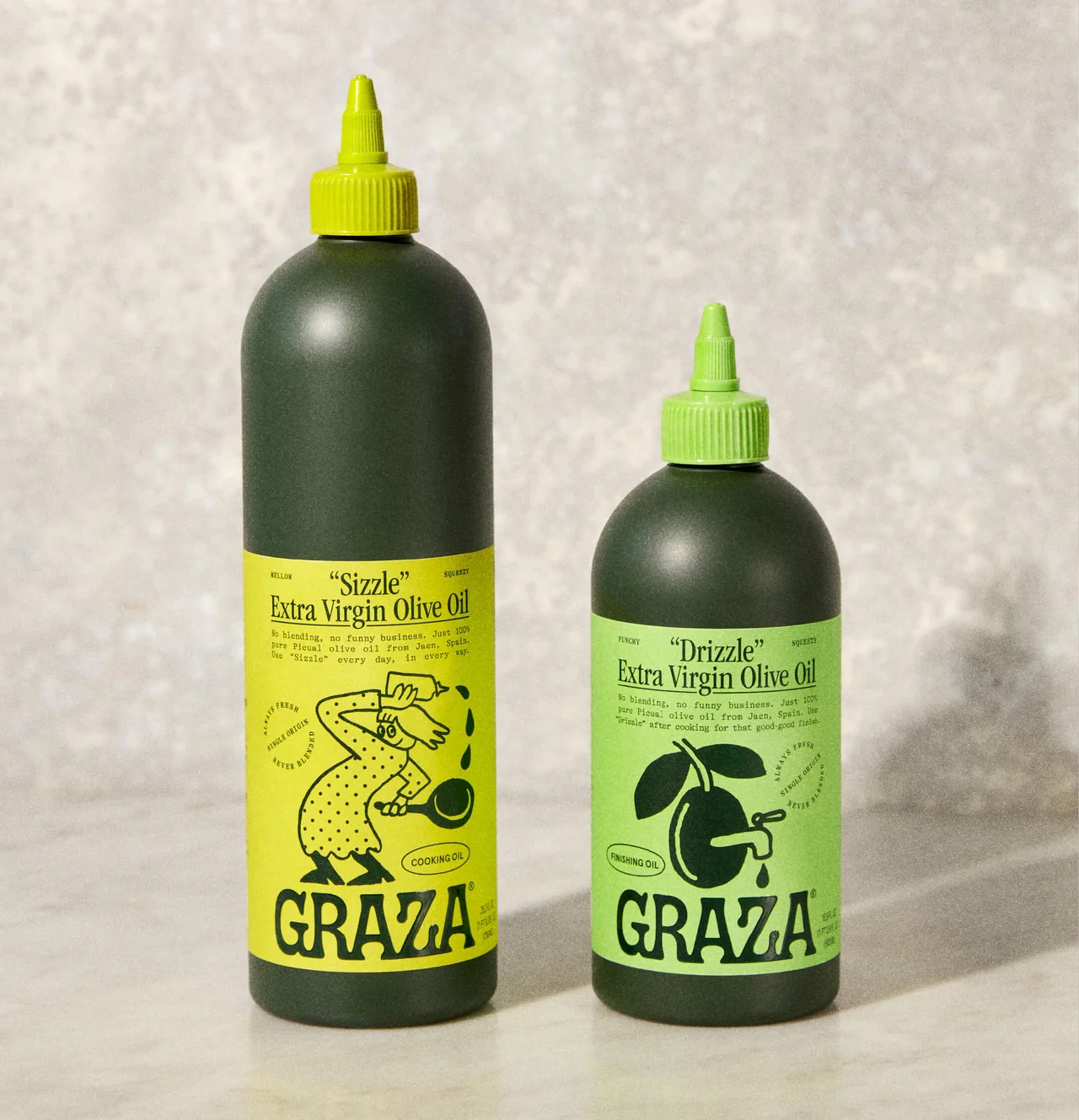
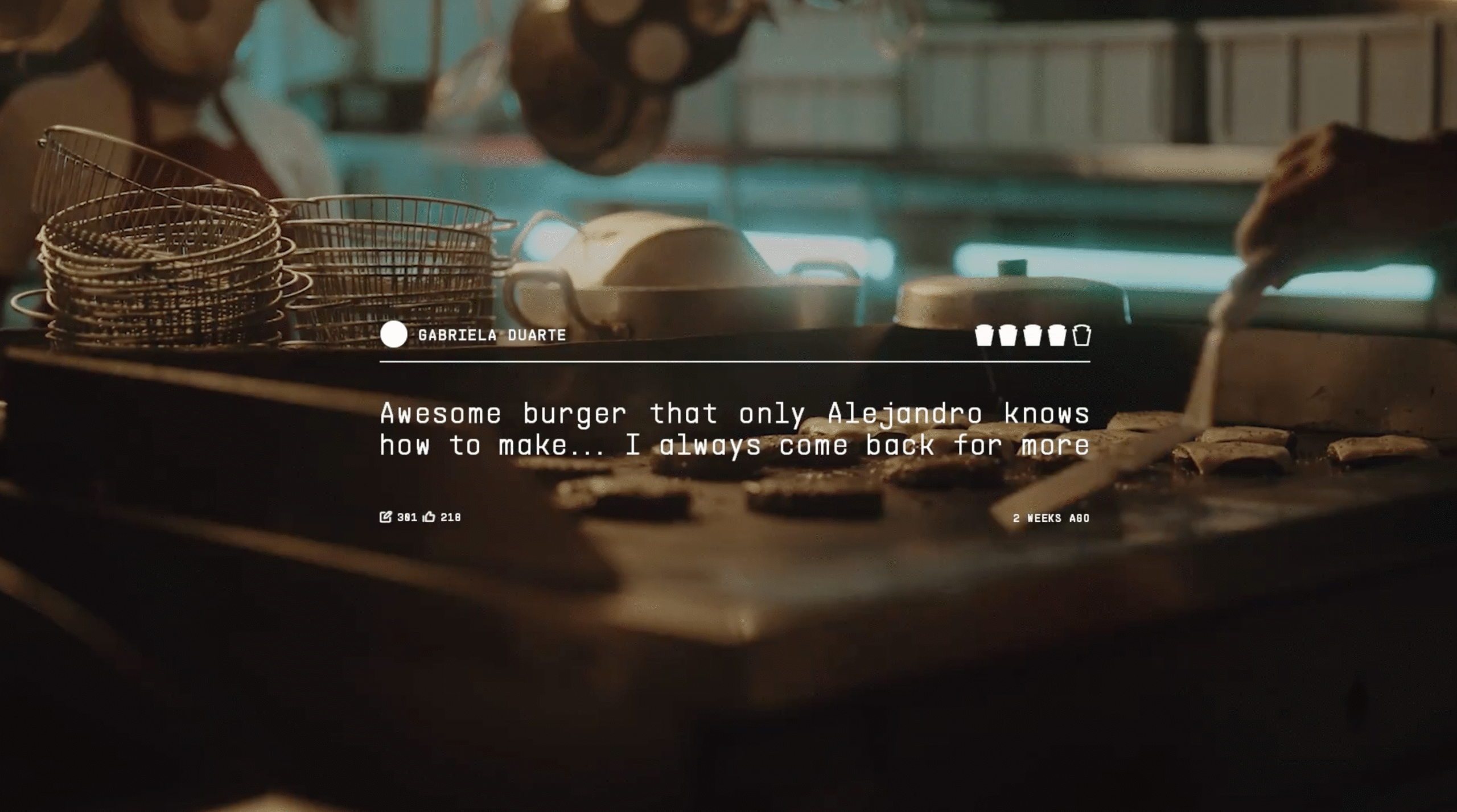
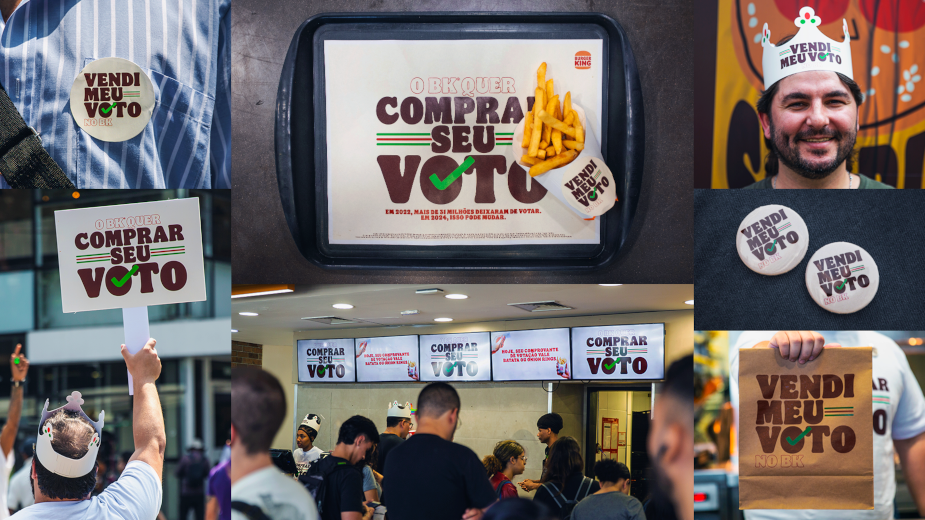
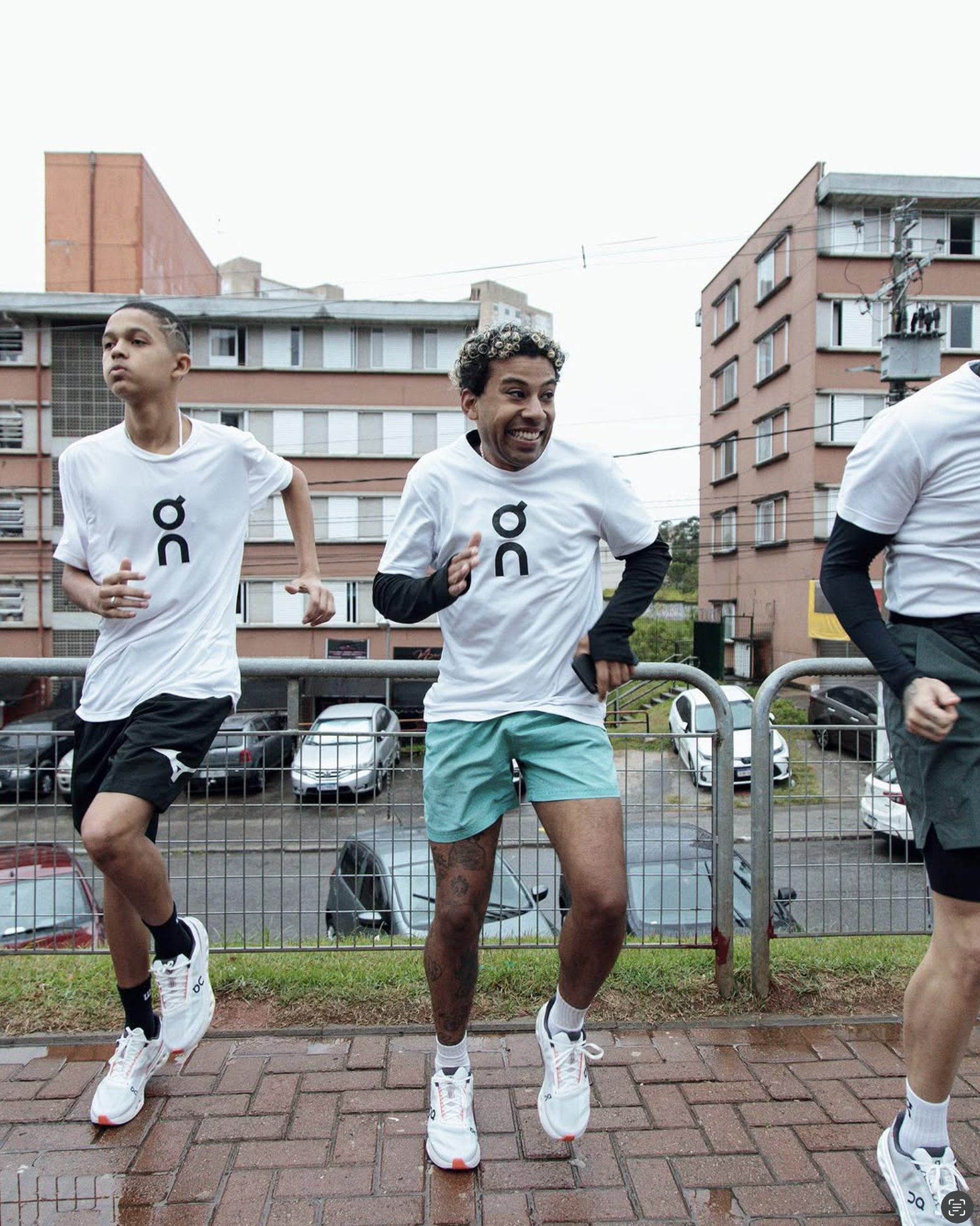
Strategy 2 – Decode the modern man
- The Dollar Shave Club, a US men’s grooming company, launched a campaign inspired by the concept of a secret gentlemen’s club. The narrative centres around a young man who joins the club, where he encounters three older men of different ages and body types. This approach promotes body diversity and age representation for men
- The UK suicide prevention charity CALM launched a new campaign aimed at encouraging people aged 18 to 24, particularly men, to talk about their mental health. The ad utilised the traditionally hyper-masculine UK rap genre Drill to resonate with youth. Lyrics encourage listeners to check in on their loved ones and remind them to be patient in difficult times
- In the UK, Newcastle United Football Club promoted its sensory room for neurodivergent fans through a campaign featuring Tyler, a young autistic fan who finds comfort there amid loud noises and crowds. The initiative aimed to encourage kindness and acceptance in a traditionally masculine community
- To celebrate Lunar New Year, Apple shot a 12-minute film in China, called I Made a Mixtape for You. The campaign follows a young man facing societal pressure to find a partner and get married. It emphasises the complex dating culture and traditional expectations in the region, showcasing solidarity among young men going through this life stage
Strategy 3 – Push for DE&I to court rising youth
- Brazilian telecommunications company Vivo launched the short film Amores Pretos (Black Loves), which portrays love as a tool of resistance and equity during Black Awareness Month. Alongside activations, Vivo presented the film at a street cinema on Black Awareness Day in Brazil
- Skincare brand Nivea teamed with Amazon to launch an ad celebrating skin tone diversity in Saudi Arabia through limited packaging that used data and skin analysis to represent a range of skin tones. The box arrived with the tagline “MY SKIN IS MY_______” to invite shoppers to reflect on their relationship with their skin and feel empowered
- In the UK, Crystal Palace Football Club offers visually impaired fans GiveVision to watch live matches. The headsets stream real-time footage to users’ retinas, letting them follow players’ movements from any stadium seat
- On the International Day of Persons with Disabilities, LEGO teamed with Hidden Disabilities Sunflower to launch three sets which included LEGO DUPLO bricks with sunflower symbols. The sunflower symbol quietly communicates that a person has a non-visible condition and may need extra time, understanding or space in public areas
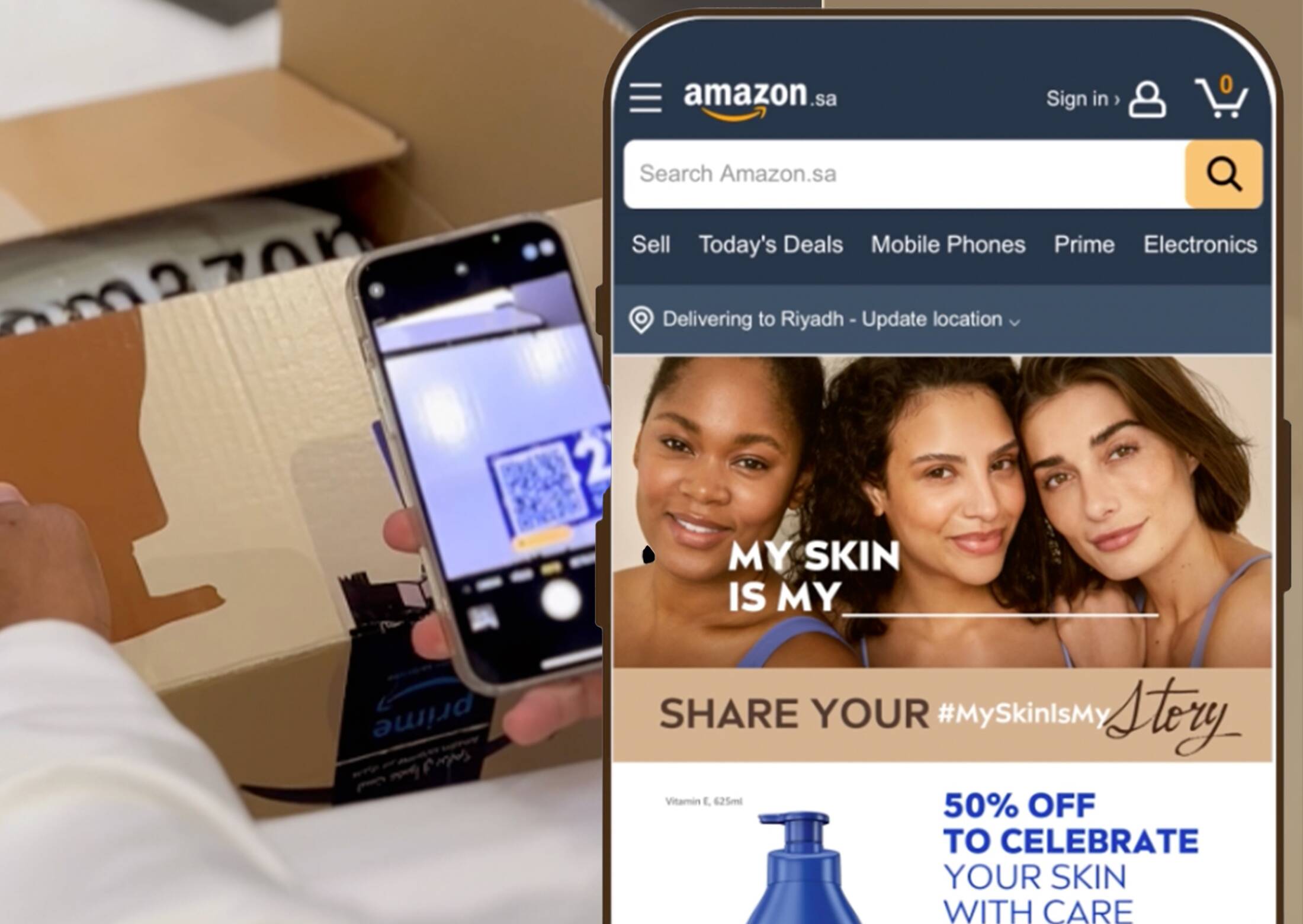
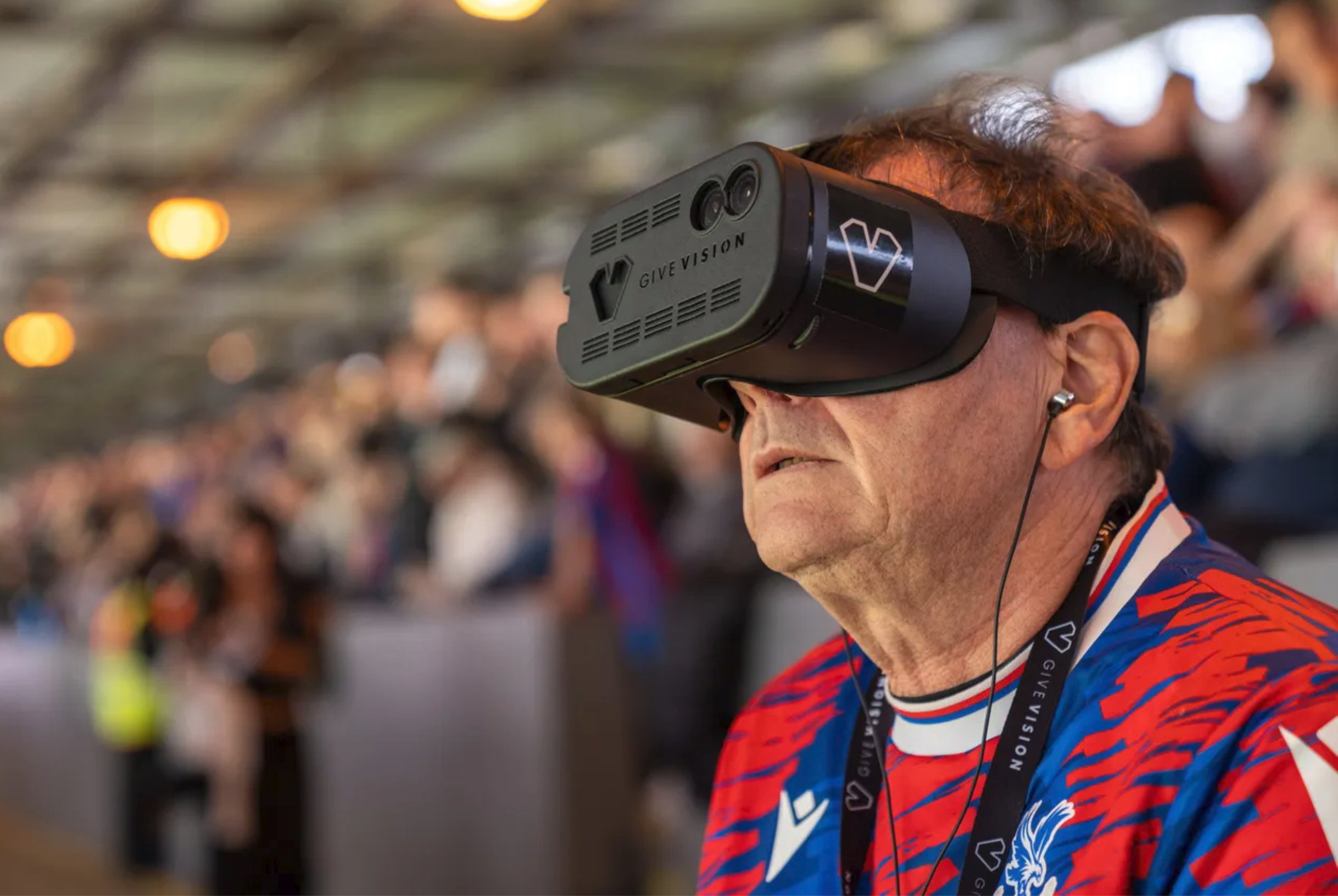
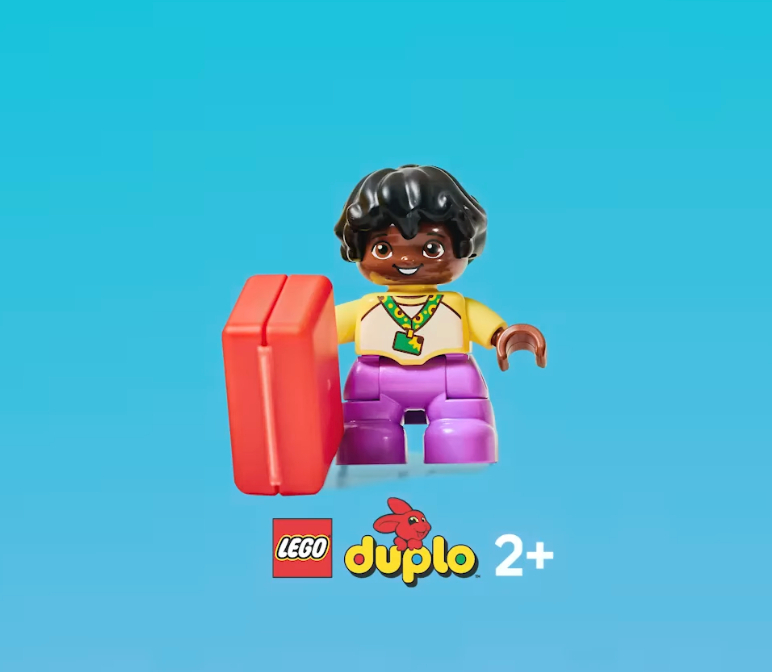
Strategy 4 – Embrace play when communicating sustainability
Strategy
- Invest in playful brand touchpoints that educate and encourage consumers to develop more sustainable habits. With consumers experiencing burnout, and with eco-anxiety on the rise, being playful with climate change messaging can inspire learning through childlike wonder and better actions. Foster hope, despite the doom and gloom, to curb some of that anxiety.
- In 2026, play as resistance will become an essential tool to tackle the climate emergency in a more actionable and positive way. A global survey found that 74% of consumers believe we are on a path toward a climate disaster unless we alter our behaviours (YouGov). Embedding playfulness into messaging and actions will push consumers to change their habits to align with their values and move them up the green line level of sustainable affordability.
In action
- A US art collective, MSCHF, launched a humorous and dark microsite raising awareness around the consumption of leather goods and meat and its impact on the planet. It features Angus the cow, who is offered for pre-sale in the form of 1,200 burgers and four leather bags. Consumers can pre-order a set of three Angus burgers for $35 or a handbag for $1.2k and will receive an Angus token through the mail. Production will go ahead if all tokens are sold. However, if 50% of the pre-orders are cancelled, Angus will be saved from being sent to the slaughterhouse
- Indian snack company Britannia launched its annual sustainability report with an OOH ad that reinforced its sustainability values and ethos. It planted billboards that took the shape of trees and nature around them with the tagline “Nature shapes Britannia”. The campaign demonstrated that marketing stunts can be conducted without harming nature
- Car brand Chevrolet teamed up with California-based upscale grocery chain Erewhon to release the limited-edition Equinox EV Electric Juice, inspired by the brand’s electric Equinox EV car. The collaboration aimed to highlight both brands’ serious commitments to the planet, from Chevrolet’s dedication to creating zero-emissions vehicles to Erewhon’s sustainable and organic sourcing practices
- In Bulgaria, grocery store Lidl unveiled a pop-up stunt called The Conscious Grocery Store. Consumers could scan barcodes to learn about Lidl’s recycling initiatives and learn about meat and dairy alternatives

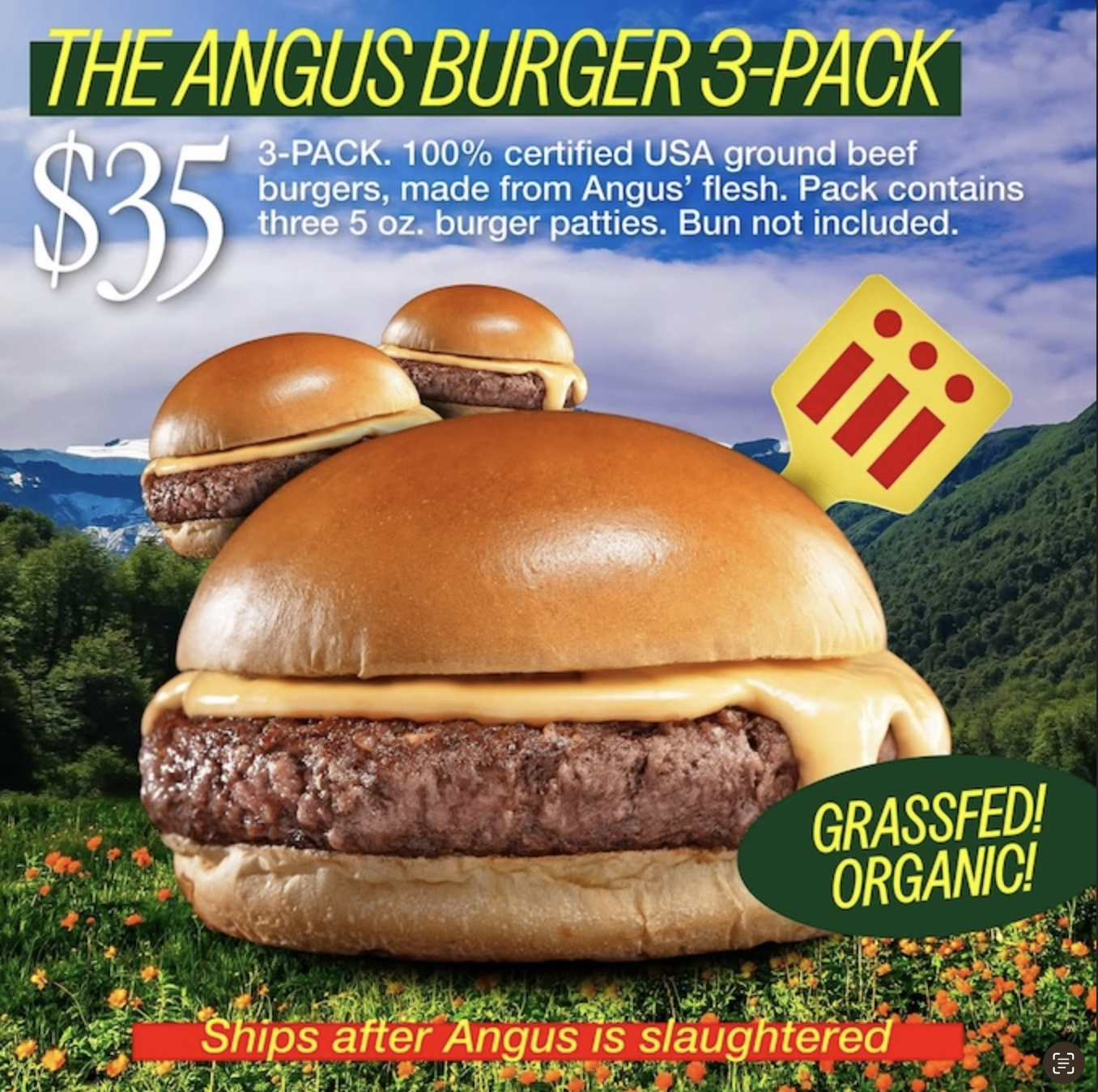
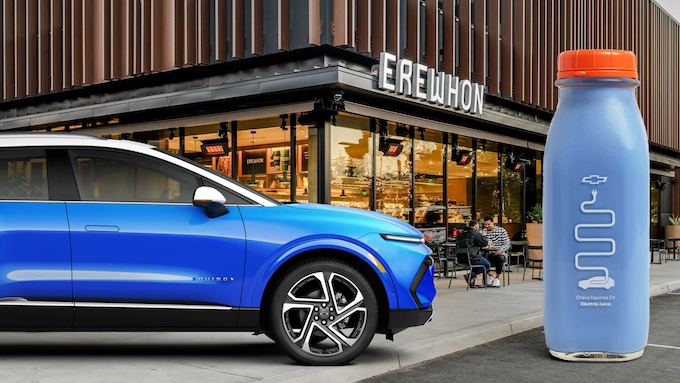
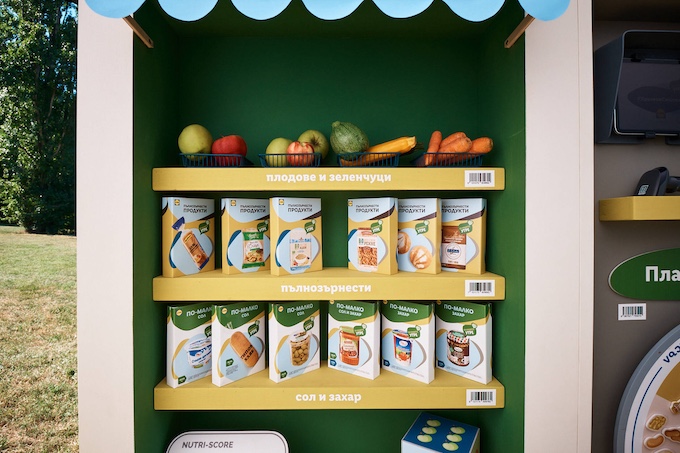
Explore storytelling on the soft/chaos scale
Content marketers will take a two-pronged approach to storytelling, balancing softer narratives for mature audiences with chaotic, snackable formats for younger generations.
Framework – Storytelling on soft/chaos scale
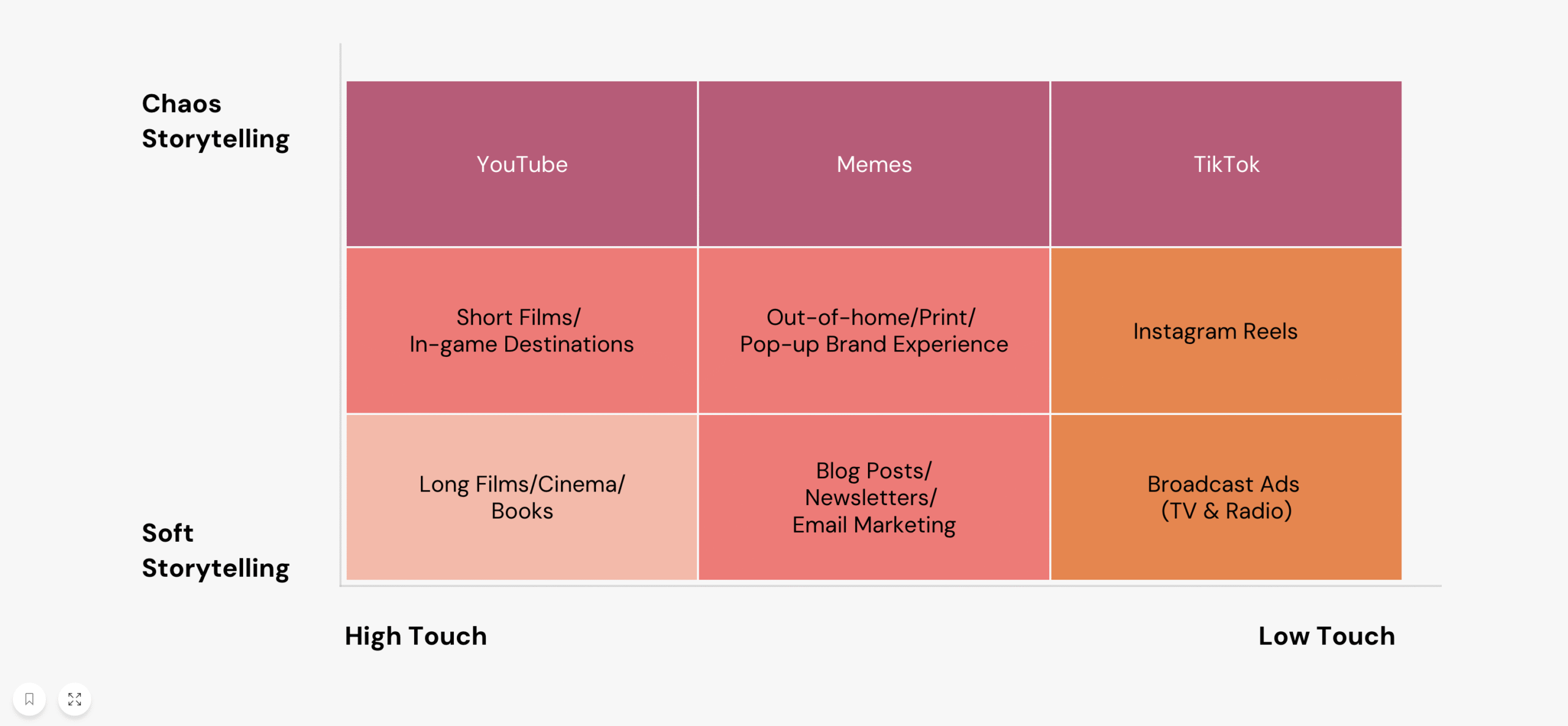
Strategy 1 – Push creative boundaries with long-form content
- On World Book Day, automotive brand Audi collaborated with Penguin Random House to address the lack of consumer interest in car manuals. Launched in Spain, the project featured seven Spanish authors who wrote original short stories incorporating specific words and phrases from Audi’s manuals, transforming technical content into engaging fiction
- Puerto Rican musician Bad Bunny launched a short film to commemorate and tease his latest album, DeBÍ TiRAR MáS FOTos. Made in collaboration with Puerto Rican filmmaker Jacobo Morales, the short film amassed 14.8m views 12 days after its debut
- US food delivery company DoorDash published Secret Menu, a digital and print magazine for the restaurant community. It features stories aimed at inspiring and connecting foodies while celebrating local restaurants and communities in various American cities. Publishing a magazine allows fans to engage offline
- In Tokyo, Spanish fashion house LOEWE hosted an exhibition titled Crafted World Tokyo, showcasing its history and commitment to craftsmanship. Tapping into multisensory marketing, it takes attendees through Spain’s sights and sounds, transports them to fashion shows in Paris and through a series of interactive rooms featuring past and present collaborations

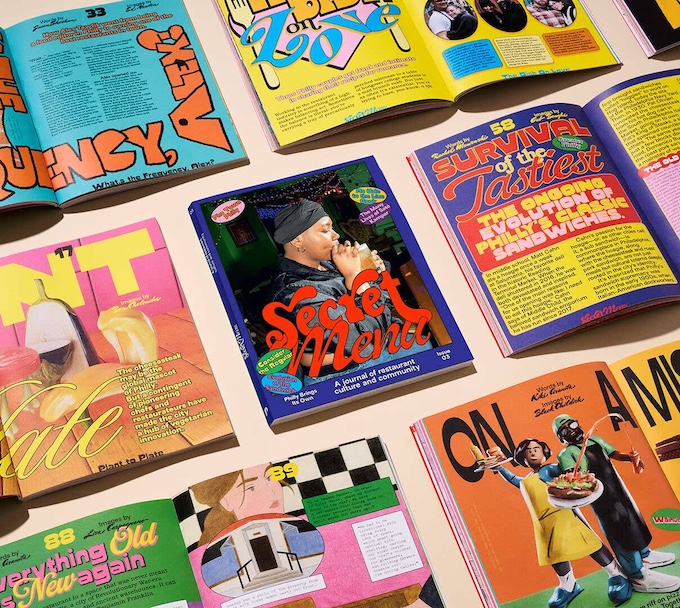
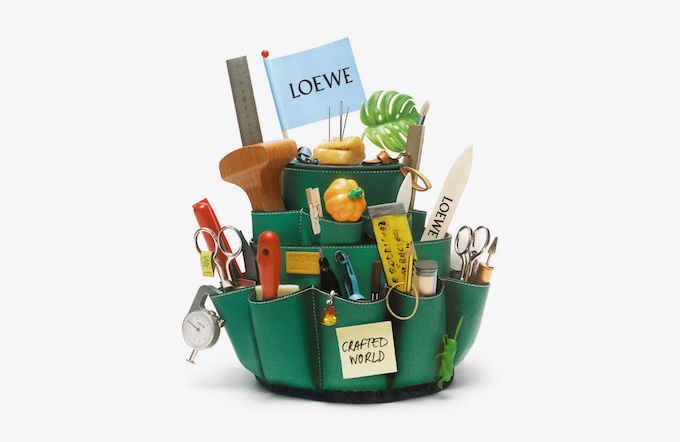
Strategy 2 – Develop a split-brand personality
- Spanish luxury house LOEWE has created two distinct and contrasting brand identities and content for its Instagram and TikTok pages. On TikTok, the brand leans into slanguage and meme culture, such as “healing my inner child” and “Kiki vs Bouba”. It takes a more polished and mature tone when posting on Instagram by featuring lookbook and campaign images and focuses on LOEWE craft
- French luxury brand JACQUEMUS has created a strong visual identity on Instagram and TikTok with its video and photography campaigns, generating excitement among fashion enthusiasts. It shares sophisticated and refined content on Instagram but adopts a more casual and quirky style on TikTok that leans on trends or trending audio
- Marc Jacobs intermittently posts chaotic, meme-inspired content with brain rot-style edits to promote products on TikTok to attract youth
- UK non-profit organisation Royal Society for the Protection of Birds (RSPB) has created two social media personas to diversify its engagement. On Instagram, RSPB posts thoughtfully curated and polished content about saving and protecting birds. On TikTok, it remixes slanguage, meme edits and surreal humour to engage with younger audiences


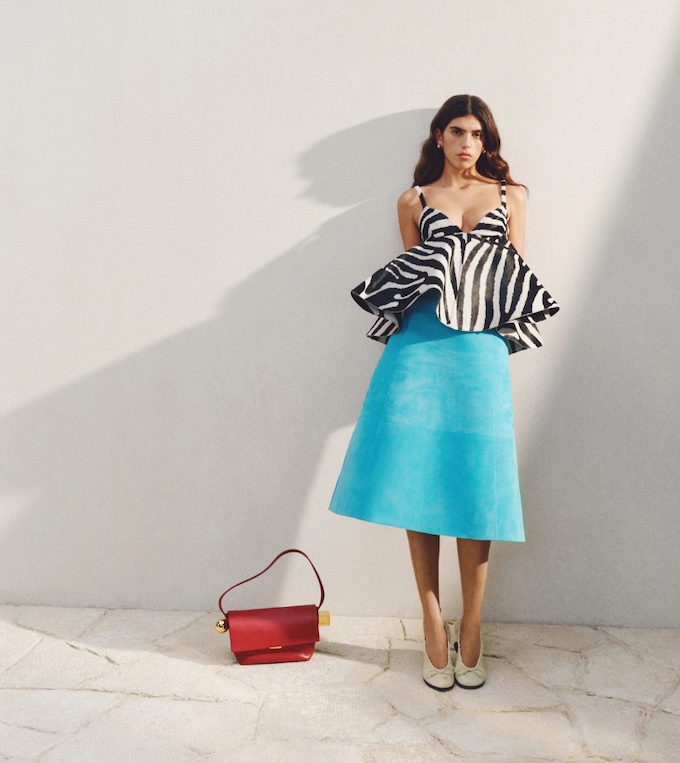
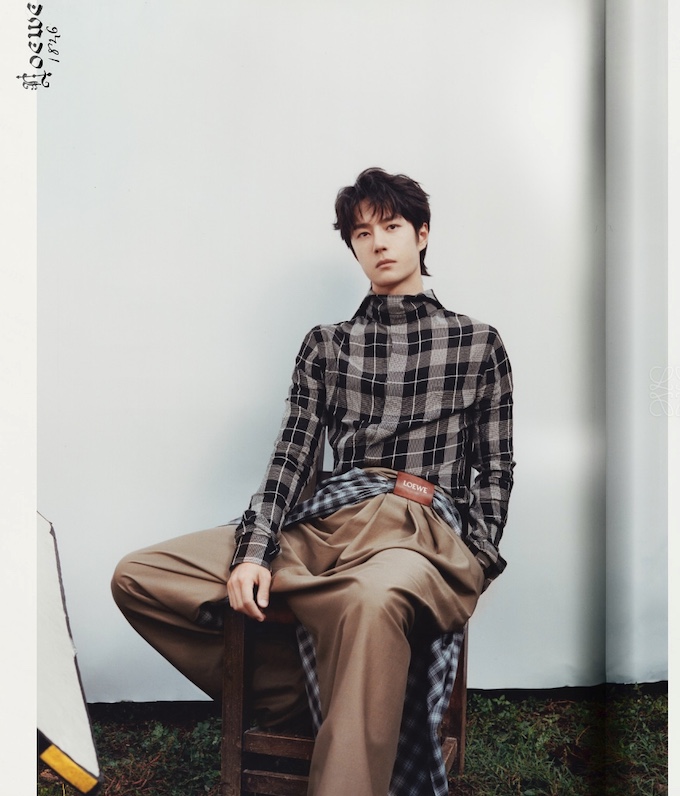
Strategy 3 – Lean into brain rot
In action
- US snack brand Nutter Butter strictly publishes brain rot content on TikTok. Its content strategy focuses on driving engagement with fans through likes and comments. Despite brain rot being lo-fi, the brand has curated and established an unmistakable visual content style
- Fast-food chain Taco Bell occasionally leans on collage-style visuals remixed with random video edits to align with younger fans. Tapping into brain rot enables brands to showcase how hyper-online they are
- Doughnut chain Dunkin’ borrows elements from brain rot content as part of its social media strategy on Instagram and TikTok. It uses slanguage and bad taste imagery to capture the lo-fi aesthetic of brain rot
- In the UK, KFC’s TikTok page is filled with brain rot, random, surreal and absurd edits. It uses anthropomorphic versions of its chicken buckets with slanguage terms like “Skibidi” and “hawk tuah” to resonate with Gen Alphas on the platform




Apply the rules for the new value system
To thrive amid geopolitical uncertainty, marketers will embrace a fresh value system centred on empathy, resonating with an audience more aware than ever of class dynamics and social equality.
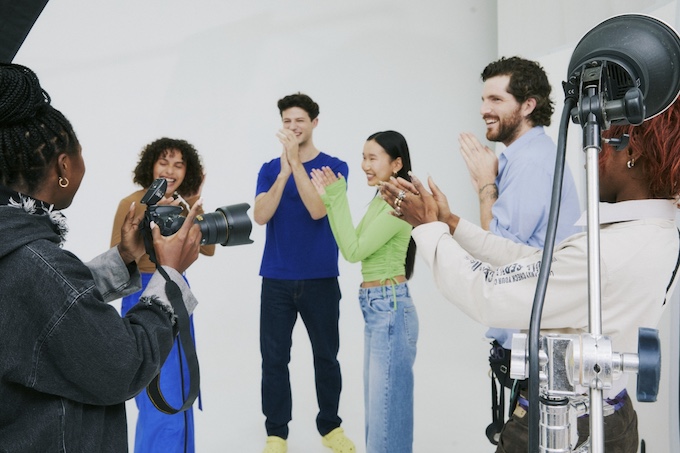
Strategy 1 – Embed restorytelling for reinvention
- South African fashion designer Thebe Magugu draws on his rich cultural heritage to bring folklore and stories to life through his collections. He expresses his storytelling through illustrations and imagery, showcased in the Magugu House flagship store in Johannesburg. The welcoming space redefines luxury, inviting customers to explore the brand’s essence and engage with its narrative through immersive storytelling
- PUMA took a thoughtful approach to temporarily rebranding in India by collaborating with badminton star PV Sindhu, temporarily transforming its branding to ‘PVMA’. This move demonstrates the brand’s commitment to connecting with the local audience and leveraging badminton’s position as India’s second-most-popular sport after cricket (Statista)
- Leica, renowned for its iconic camera technology, is evolving its century-old legacy into a lifestyle brand with a purpose, which is to inspire and enable the creation of meaningful moments. While its products are positioned as luxury items, Leica is tapping into the renewed enthusiasm for photography. With galleries stretching from New York to Kyoto, it creates spaces that celebrate the art of photography and provide platforms for emerging talents to showcase their work with Leica’s innovative technology
- The Hyundai Heritage series is a nostalgic homage to the brand’s classic car models from the ’70s and ’80s, updated as all-electric versions. The initiative spanned content marketing on Hyundai’s site and social channels
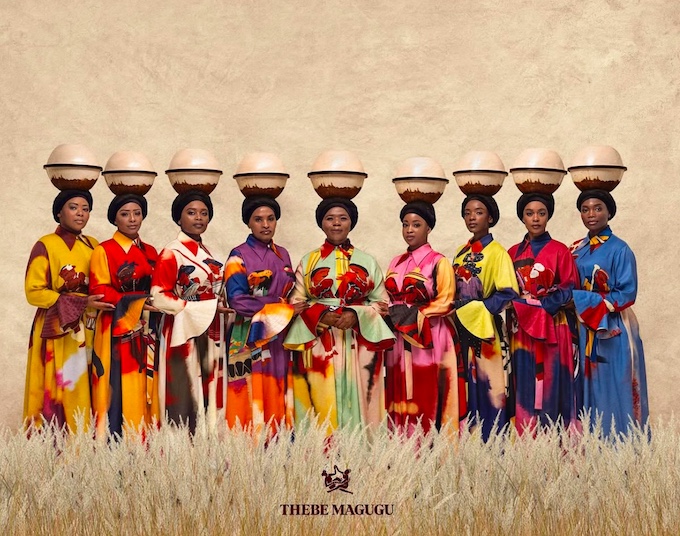


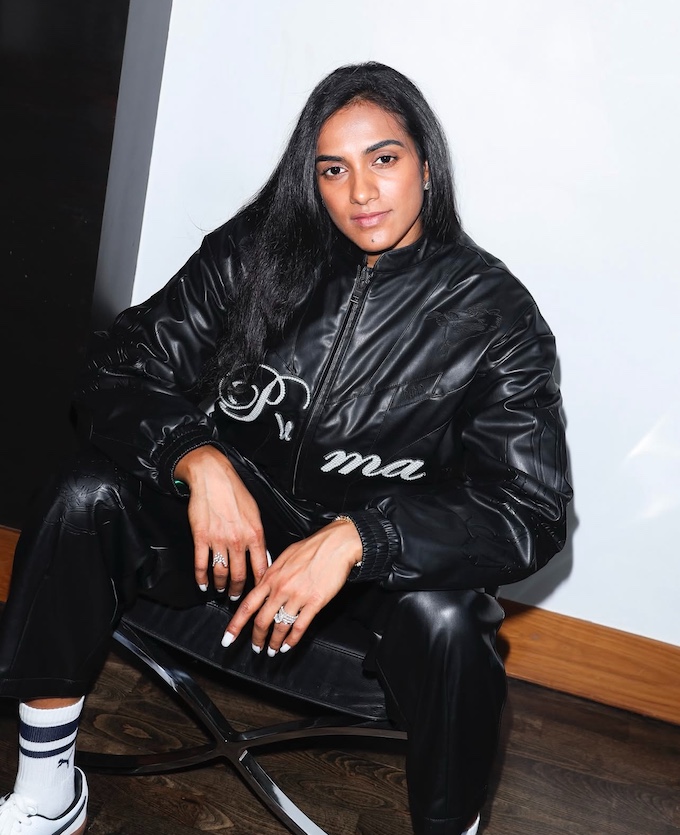
Strategy 2 – Build brand consciousness
- In its 2024 Christmas campaign, O2 spotlighted the National Databank, addressing data poverty (difficulty paying for internet connections) affecting 1.9m UK households (Ofcom). Partnering with the digital inclusion charity Good Things Foundation, O2 provides free mobile data, texts and calls to those in need, so they can stay connected
- UNIQLO launched The Heart of LifeWear, a global initiative to donate one million HEATTECH thermal garments to those in need. It highlights one of its hero products while extending support in Japan, its country of origin, and internationally. In Japan, UNIQLO donated 100k HEATTECH items to those affected by the 2024 Noto Peninsula earthquake
- Ben & Jerry’s, the leading ice cream brand in the US, seamlessly integrates its core values and social advocacy into its brand identity. Leveraging its social platforms, the company amplifies local and global causes, mobilising communities to take action on environmental, social and political issues. In the wake of the newly elected US government, Ben & Jerry’s rallied followers to join a peaceful People’s March to remind elected officials that all US citizens should have access to fundamental rights. In the UK, its efforts extend to empowering organisations working to support refugees seeking asylum
- Through its Action Works portal, Patagonia empowers customers with resources to get involved with hyper-local organisations spanning climate, biodiversity, community, water and land issues. The portal hosts petitions and volunteering opportunities and serves as an events noticeboard
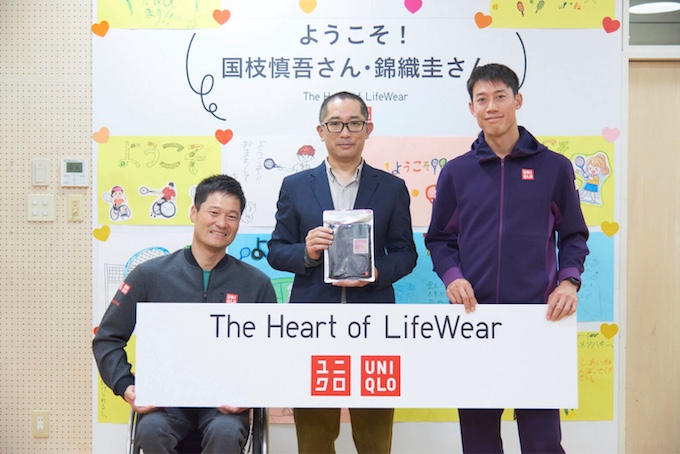
Strategy 3 – Foster loyalty for good
In action
- To support consumers facing economic challenges and shifting dining habits, Taco Bell launched a “name your price” tool on its app. This allows users to set a specific spending limit and generate a randomised selection of menu items within that budget. By empowering customers to discover affordable options, Taco Bell not only enhances convenience but also strengthens engagement within its app ecosystem, seamlessly integrating with its loyalty programme to drive retention and brand loyalty
- Discovery, a South African financial services organisation, launched Vitality Fitness in addition to its Vitality programme. Informed by a new company white paper, Vitality Fitness aims to improve clients’ cardiorespiratory fitness by offering access to various workouts through a network of fitness studios and gyms nationwide. Cardiorespiratory fitness is an indicator of longevity, as even moderate improvement can reduce the risk of death by 21-30% (Discovery Vitality)
- Charlotte Tilbury enhanced its loyalty programme with exclusive experiences beyond product rewards. Members can access private events, masterclasses with experts and the Beauty Secrets Quiz, which shares backstage tips and techniques. This offers members a deeper connection with the brand while refining their beauty skills
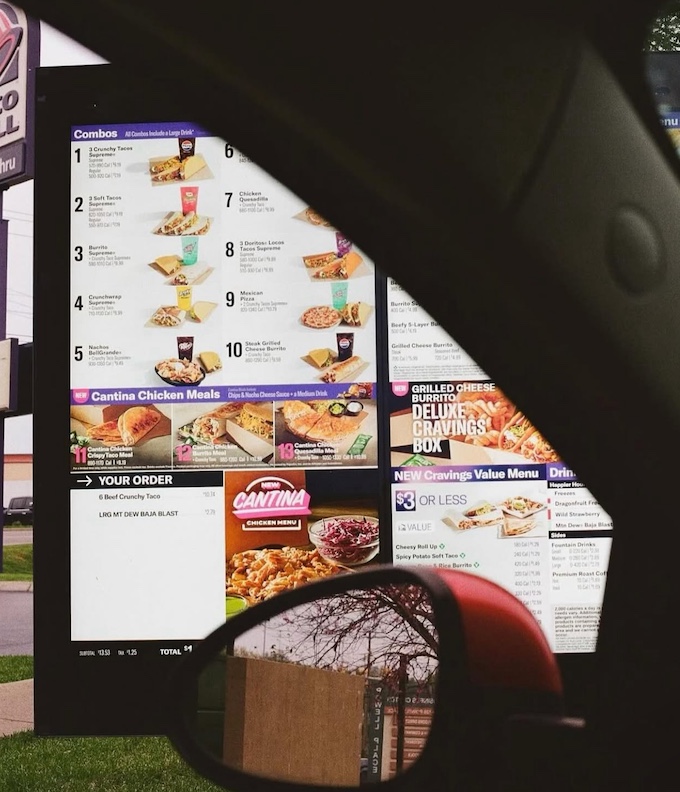
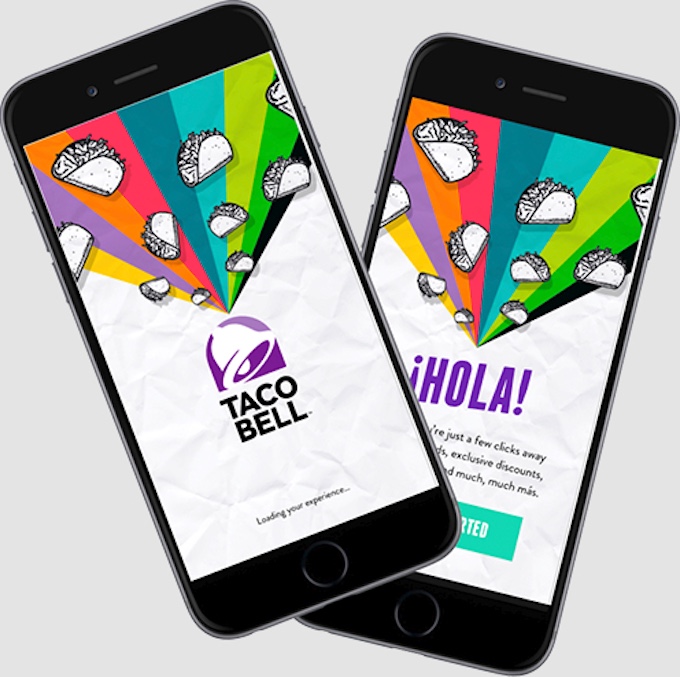


Develop emotioneered moments
Harness the power of emotions to connect with consumers seeking positivity amid societal challenges.

Emotional targeting will be top of mind for marketers as emotions are the ultimate driver of consumer behaviour. Topgolf aimed to capture the joy of playing based on players’ brain activity at its facilities. Teaming with neuromarketing company Glassview, it served content during the 2024 COPA and Euro tournaments which resulted in a 13% spike in brand favourability
Strategy 1 – Build glimmers into seen spaces
- Oatly collaborated with The Golden Spurtle Championship, a porridge-making competition in the Scottish highlands, to document competitors’ stories and engage with locals on their opinions of Oatly. This resulted in a heartwarming brand campaign that allowed Oatly to connect with the local community while creating an opportunity for people to bond over their shared interest in porridge-making
- Australian skincare brand Aesop showcased a short film, The Soap Service, which screened at several stores across Hong Kong. Aesop also partnered with the Hong Kong Asian Film Festival to showcase Asian cinema. Before each screening, viewers watched The Soap Service while being treated to an Aesop fragrance infusion for an olfactory experience
- UAE gaming cafe Racks specialises in a curated collection of board games. It has multiple game zones for varying group sizes and a large communal table where customers can meet new people. The space is ripe for brand integration with a pop-up that doubles as a community hub
- Paris-based brand Alaïa opened a bookstore in its London flagship in collaboration with Claire de Rouen and Violet Cakes. The space served as a hub for book enthusiasts, featuring rare titles from across the arts

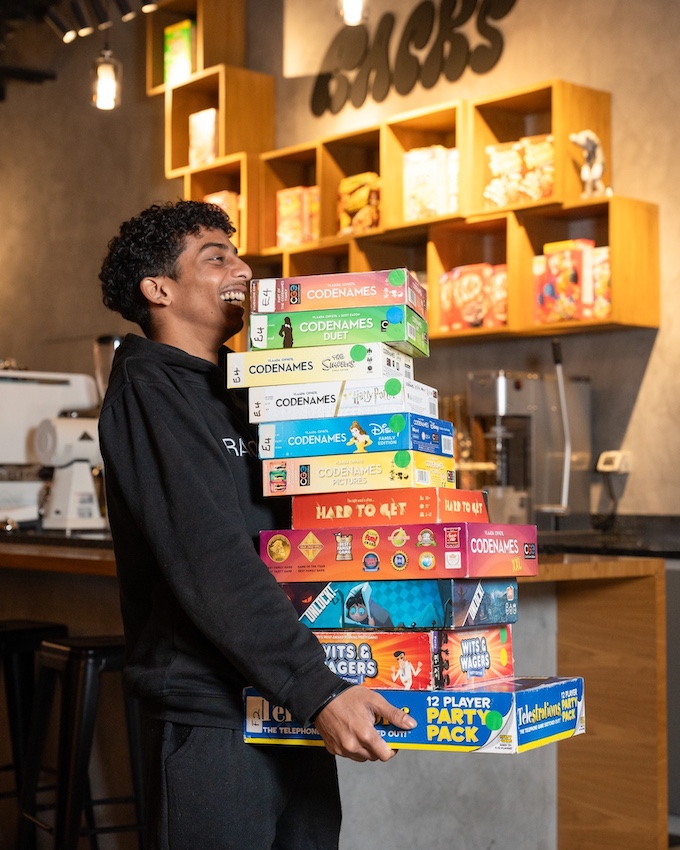

Strategy 2 – Communicate feel appeal

Swiss furniture brand USM partnered with boutique hi-fi audio manufacturer OJAS to host a Listening Room in its Soho showroom in New York City. The listening room was free and open to the public, allowing anyone to walk in and experience it, whether or not they intended to spend on the luxury price points of either brand
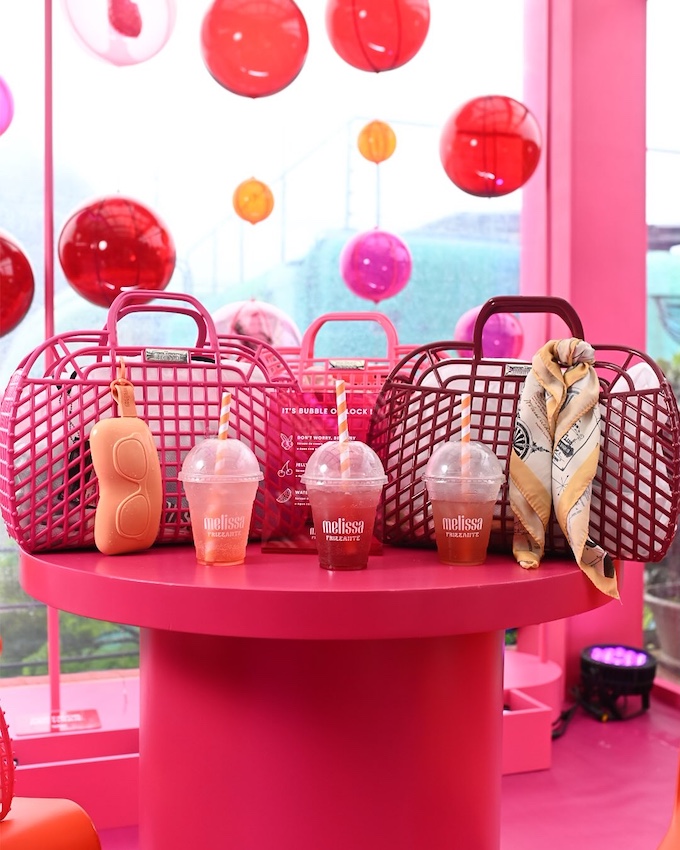
To celebrate its iconic jelly shoe, Brazilian footwear brand Melissa developed different flavours of Italian lemonade inspired by the new shoe colours at its pop-up activations in France, Italy and Brazil. The immersive experience allowed consumers to engage with multiple senses, from taste to touch and sight
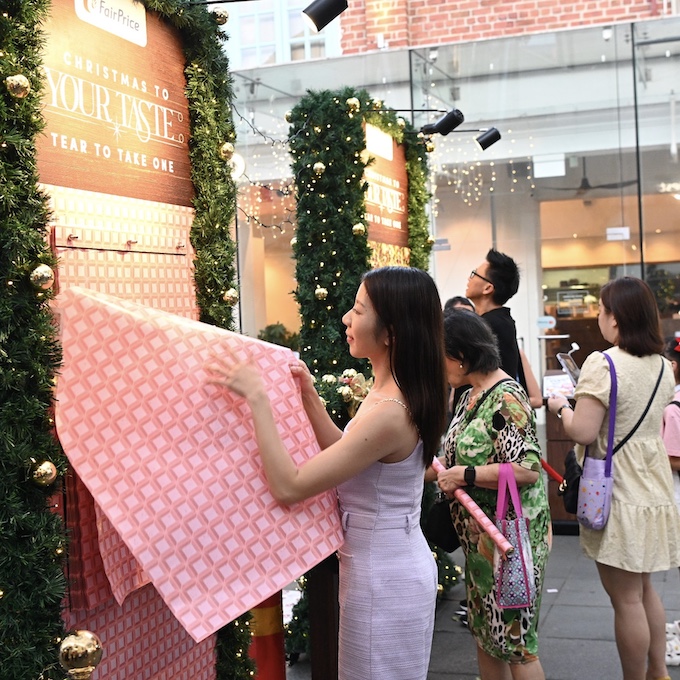
Singaporean supermarket FairPrice built multisensory billboards for its Christmas to Your Taste campaign. Shoppers were invited to take the wrapping paper infused with food-flavoured scents home as samples and try the dishes that inspired the design

For World Mental Health Day in October, Spotify launched its Take a Beat campaign, which aims to push consumers to embrace nature sounds in their daily routines, which research has proven is good for mental health
Strategy 3 – Inspire dopamine nudges
- For New Year’s Day, Dove launched an OOH campaign showcasing the role of its Beauty Bar in unwinding after a night out. The Unready for Anything campaign celebrates the authentic aspects of beauty routines and highlights the product’s essential role during special moments
- Haircare brand Timotei launched a podcast series that encourages listeners to tune in while washing their hair. Covering topics such as motherhood and self-care, the podcast aims to serve as an educational tool for integrating slow living and wellbeing habits into daily routines
- To raise awareness of World Mental Health Day, Lululemon hosted a series of wellbeing events worldwide, including an interactive takeover of the Shanghai Start Museum in collaboration with Graphic Rewilding, called The Wellbeing Garden. The temporary exhibition featured fitness classes and aimed to inspire mindful movement
- PUMA India and Bumble partnered for a Singles’ Day running event in Bangalore. The initiative urged singles to connect meaningfully and reminded them to foster relationships IRL

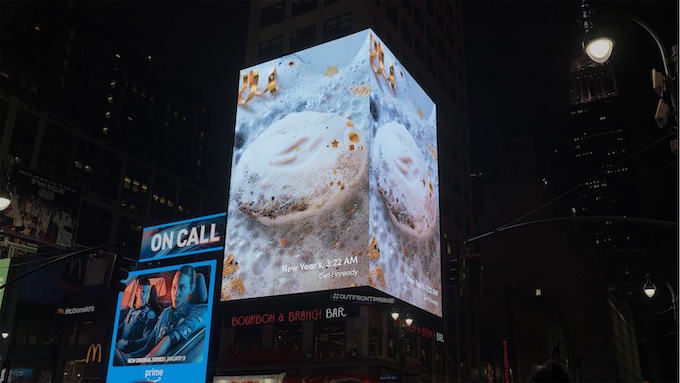
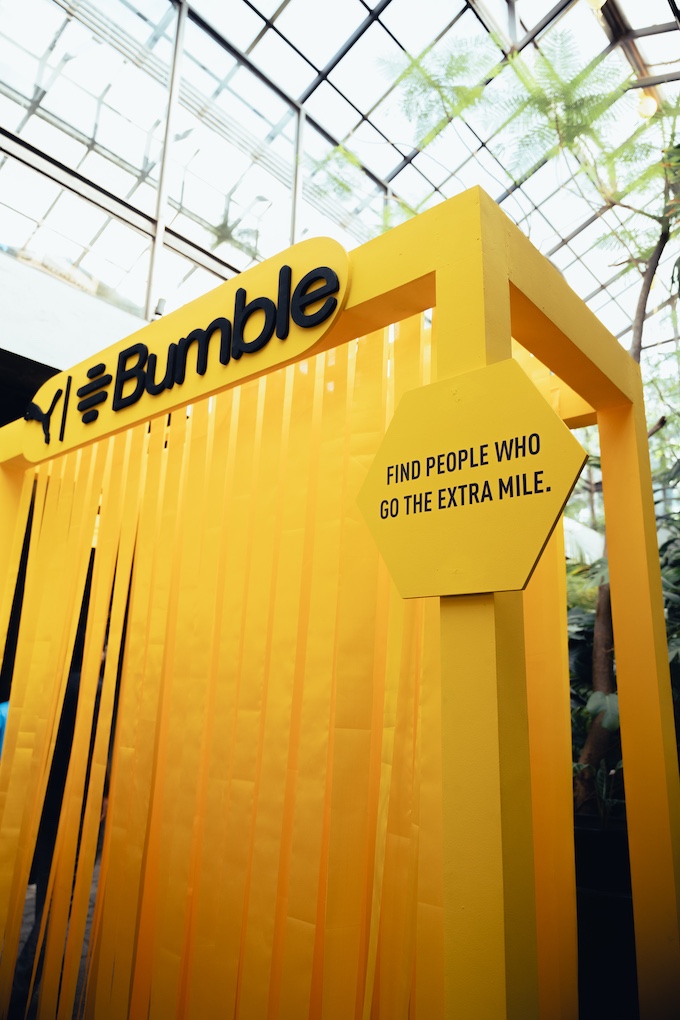
Apply intention to creativity
The low-trust attention economy will challenge marketers to dream up more meaningful ideas. Quality over quantity will be the mantra as intentionality becomes key.

Strategy 1 – Fight back against ‘AI slop’
- In an ad for Discover, White Lotus actress Jennifer Coolidge sits at her kitchen table while speaking to a human customer service representative who turns her inevitable question back on her: how does she know she’s not a robot? By emphasising the option to speak to a human, the ad introduces Discover’s AI chatbots to consumers in a balanced way
- Meta’s 2024 ad positions its AI tool as an assistant that can help people connect and learn. The vibrant aesthetics and human personalities in the ad are punctuated by shots of generative AI text and images, reassuring the viewer that AI is there to help, not take over
- Microsoft’s ad for CoPilot, its AI assistant, demonstrates how it can help young creatives meet their goals by generating storyboards, writing code or mocking up ideas. This aligns with the way that creatives are currently using generative AI, and how they hope to use in the future
- A Brazilian ad for photography giant Canon educates viewers about AI possibilities and limitations by showing how inputs into a text-to-image model are similar to a person’s perspective behind the camera lens
Strategy 2 – Launch practical ads that pack a punch
- During Sweden’s chilly summer, IKEA launched a reflective billboard affixed with GPS that moves with the sun’s movement throughout the day. The billboard directs natural light onto the city streets below and warms a select number of restaurants while advertising the mirror
- Protein snack brand RXBAR rejected the toxicity of New Year’s resolutions with its campaign that included a BS Blocker truck. The OOH stunt encouraged viewers in New York to report OOH ads displaying typical ‘New Year, New You’ messages. The truck would then park in front of the ads to block the view for passersby
- US tissue brand Kleenex and Amazon launched the KleenEX: The Breakup Calculator, a digital activation designed to help consumers cope with the grief of breaking up with a partner. The brand encouraged singles to share the details of their separations for personalised healing journeys and product recommendations from Amazon that could help with loss
- Publicis Groupe Japan has a committee for Sustainable Development Goals that runs an annual contest to raise awareness about environmental issues. It recently launched a contest called The Trash Bento Challenge, which encouraged citizens to take action against microplastic pollution. Participants were asked to use trash from their homes to create non-edible bento boxes, like green candy wrappers as seaweed or sponges as salmon
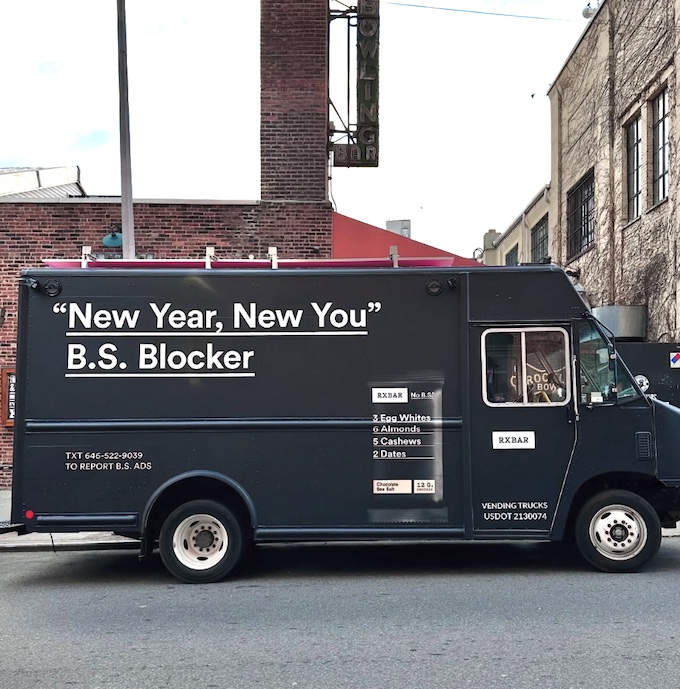
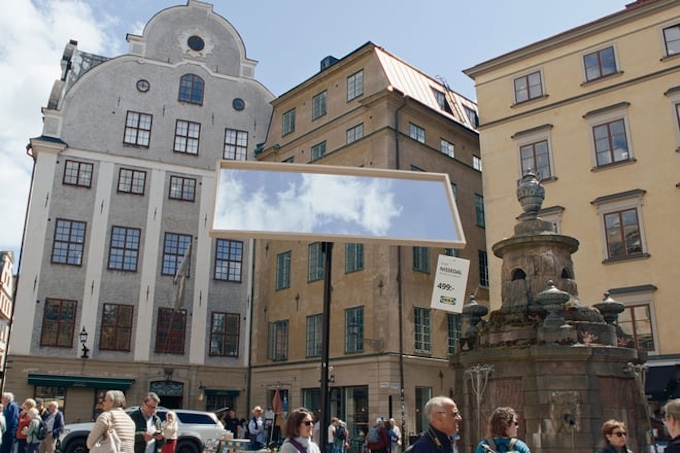


Strategy 3 – Consider alternative ad spaces
- To promote season two of Severance, Apple TV+ staged a live performance at Grand Central Station. Drawing on experimental theatre traditions, it featured the show’s real actors in costume and character, improvising in an office environment within a transparent glass cube
- For KFC’s Holiday ad, Canadian agency Courage created fully functional vinyl records that doubled as the brand’s iconic bucket lids
- In China, global denim brand Levi’s collaborated with Chinese tea brand Chagee to launch a pop-up workshop in a museum with an exhibition inspired by artist Vincent van Gogh. Participants could purchase tea with flavours inspired by van Gogh’s life in Provence
- To encourage people to enlist as US Navy Special Ops Sailors, USA Water Polo’s SkipShot magazine featured sailors in ads by seven participating brands. The subjects appeared in plain sight but the ads encouraged audiences to enlist if they were able to spot them


